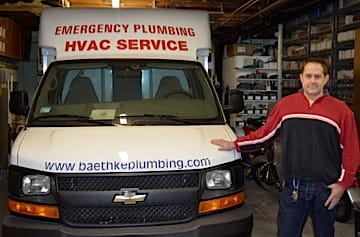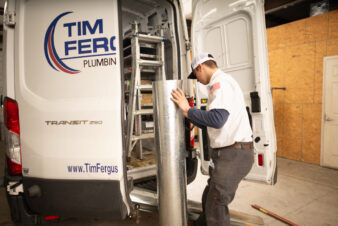 The HOT topic right now is, “how to prevent your pipes from freezing.” The first thing to remember is that a home should be plumbed in a way that prevents pipes from freezing in the first place, so ultimately the best solution is always to re-pipe or relocate pipes to prevent them from freezing. Of course, that is usually also the most expensive options so let’s go over some things that you can do that won’t be so damaging to the pocket book.
The HOT topic right now is, “how to prevent your pipes from freezing.” The first thing to remember is that a home should be plumbed in a way that prevents pipes from freezing in the first place, so ultimately the best solution is always to re-pipe or relocate pipes to prevent them from freezing. Of course, that is usually also the most expensive options so let’s go over some things that you can do that won’t be so damaging to the pocket book.
There are many different situations that will expose pipes to the possibility of freezing. The most common is when water pipes are located on an exterior wall. If this is the case, and you have the option to keep cabinet doors open, then that will allow the heat from the room to assist is keeping the pipes warm. If that still is not enough, put a small space heater in that area. Remember, though, to never leave a space heater unattended, safety is our first concern.
If the problem is that pipes in a crawl space or a basement are not heated, then installing a heat tape on the pipes can help keep them warm in days that are as cold as we are currently experiencing. There are many types of heat tape, and most are very simple — just plug into a normal outlet. The most basic ones just heat all the time that they are plugged in. I would recommend stepping up to a heat tape that is a little more automatic. There are heat tapes on the market that will only turn on when the temperature drops below a certain level. The benefit of this type of heat tape is that you are not wasting as much energy and they are more dummy proof because they turn themselves on and off.
In addition, when pipes that are not installed on an outside wall or in an unheated area, the toughest problem is that the pipes are just in a spot in the house that is allowing a draft into a joist space. We have seen this many times and it is usually the result of a poor insulation job at an outside wall when the home was built. In this situation, the only and best solution is to expose that area of draft and insulate it as soon as possible.
If you have any of the above situations you can also leave your water running at the area of concern. Running water can’t freeze. If your faucet is a two-handle faucet, make sure you have both the hot and the cold on just a trickle. If you have a single-handle faucet, make sure that the handle is positioned so that both the hot and cold side are running, and again, at just a trickle. The downside to leaving water running is obvious. You are wasting water, and if you have a slow drain you are also taking a chance of the drain overflowing. Both are not desirable.
Lastly, remember that frozen pipes do not leak. They are frozen, so the plug of ice may have split the pipe, but as long as it remains frozen you won’t even know it. That being said, when you have a line that you know is frozen make sure you know where to shut off the water before you attempt to thaw it. This way, in the event that it starts to leak, you can limit the damage. Our phones here at John Baethke and Son Plumbing don’t ring so much when the temperature drops to below zero as much as they do when the temperature rises and those frozen and split pipes start to leak.
John Baethke is owner of John Baethke & Sons Plumbing, which has served more than three generations of Chicago residents with superior water heater repair, broken pipe repair, leaky faucet repair and full plumbing systems.




Join the conversation: